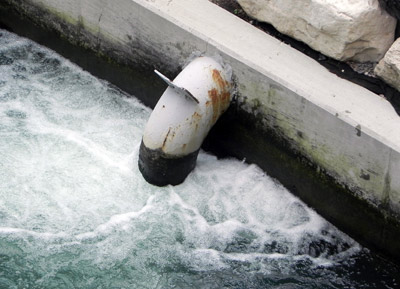Along the Pier

Back to Along the Pier
Back to Along the Pier
But when it rains...
Even though the Chicago River now flows towards the Mississippi, polluted water still spills backwards into the lake. The culprit is stormwater that flows off rooftops, parking lots, roads, and sidewalks and into sewer overflow pipes that empty into the river. Less than an inch of rain is all that is needed to flood the city's sewer system and force water into the river. During big storms, the river can become so swollen with stormwater that officials have to open the Chicago Harbor Lock and let water flush into the lake to prevent the city from flooding.
It is not just water that fills the river and pours into the lake when it rains. Stormwater brings with it a toxic blend of pollutants from city streets and lawns – everything from gasoline and trash to fertilizers and pesticides. In fact, stormwater is one of the biggest sources of water pollution. These contaminants degrade water quality, raise water temperatures, and suffocate fish eggs and newly hatched larvae. Bacteria carried in rainwater can also make swimming in the lake dangerous. In fact, stormwater is behind most of the swimming advisories and beach closures that plague the Great Lakes region each summer.
Concerns about stormwater pollution are on the rise as heavy rains are becoming more common. Between 2007 and 2013, a new high of nearly 32 billion gallons of contaminated water was released into Lake Michigan. The spike was largely because of a handfull of monsoon-like storms, some of the worst in Chicago history.
It is not just water that fills the river and pours into the lake when it rains. Stormwater brings with it a toxic blend of pollutants from city streets and lawns – everything from gasoline and trash to fertilizers and pesticides. In fact, stormwater is one of the biggest sources of water pollution. These contaminants degrade water quality, raise water temperatures, and suffocate fish eggs and newly hatched larvae. Bacteria carried in rainwater can also make swimming in the lake dangerous. In fact, stormwater is behind most of the swimming advisories and beach closures that plague the Great Lakes region each summer.
Concerns about stormwater pollution are on the rise as heavy rains are becoming more common. Between 2007 and 2013, a new high of nearly 32 billion gallons of contaminated water was released into Lake Michigan. The spike was largely because of a handfull of monsoon-like storms, some of the worst in Chicago history.
